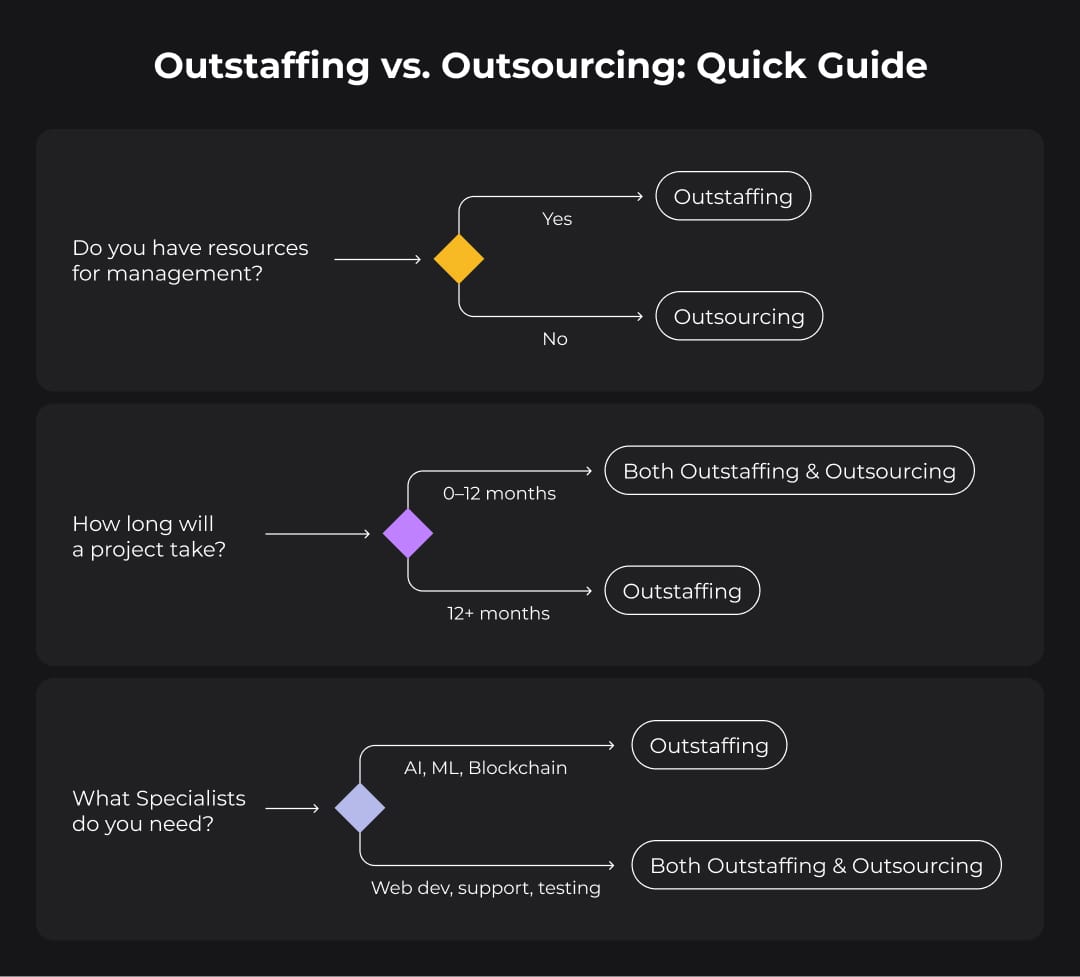More and more tech businesses face the choice between outstaffing and outsourcing, as both of the ways to delegate IT tasks are getting traction. According to Statista, the global spending on IT outsourcing services is expected to grow by 8.28% annually from 2025 to 2029. Yet, outsourcing isn’t the right fit for every business. Outstaffing provides a scalable, low-risk alternative for teams that neither don’t have the resources to scale their in-house team, not can’t fully commit to outsourcing.
Let’s see, what is the difference between software outsourcing and outstaffing and which one is more preferable and beneficial for achieving different business needs and goals. It might be up to the point if you are going to implement one of these models.
The Difference Between Outsourcing and Outstaffing
We are to start our comparison of outsourcing and outstaffing with their clear definitions.
What is Outsourcing? Outsourcing is a B2B cooperation where one company hires another company to deal with a certain scope of business tasks.
The most popular things to outsource are software development, UI/UX design, call center services, customer and technical support, and BPO services.
What is Outstaffing? Outstaffing is all about how to scale tech teams flexibly. It is a B2B cooperation where one company hires another company to source technical professionals, interview them, handpick the best candidates for the approval, onboard newcomers and become their Employer or Record. In this case, they become a part of the client’s team, but work on the outstaffing company’s premises. In fact, outstaffing is an outsourcing of HR processes.
Outsourcing vs. Outstaffing in One Sentence
Outstaffing is partnering with an agency which staffs remote teams for you and manages HR Ops, while outsourcing is delegating tasks or projects to an external team and getting the work done independently.
Outsourcing Pros and Cons
✅ The Quality Is the Vendor’s Responsibility
With outsourcing, enhancing the quality is a vendor’s responsibility. All processes are controlled and supervised by the vendor’s team. The client and their customers only get the final product. This allows businesses to free resources and direct their attention to business growth.
❌ Control Is in the Vendor’s Hands
According to the survey by Deloitte, 70% of businesses outsource to cut operation costs and improving service quality comes as a secondary option. Here is a potential challenge. Together with all processes, an outsourcing vendor takes almost the entire project control. They establish day-to-day operations and processes, provide teams with information and advice, and deal with emerging roadblocks. The client themselves might be involved in the process, but not for 100%, which might make the collaboration frustrating.

✅ No Need for Day-to-day Management
97% of businesses believe proper project management is crucial for organizational success. An average business has a 70% project failure rate that you can only decrease by proper and dedicated management. It is not always possible to achieve in-house.
Outsourcing teams provide companies with constant project supervision that can help increase a team’s productivity and provide the control required by difficult projects and tasks.
❌ Costs More than Outstaffing
Due to the additional resources spent on management and supervision, an outsourcing client doesn’t just pay for the tech team—they also cover the time and effort of the management team. When comparing the costs of outstaffing vs. outsourcing, decision-makers find that outsourcing tends to be more expensive.
✅ It is Filled with Innovations …
Outsourcing is a mature industry. It has traditions, experience, and innovations. It is constantly developing and changing in accordance with customers’ requirements and desires.
❌ … and Roadblocks
On the other hand, constant shifts can confuse professionals and cause roadblocks:
Not all tech professionals can follow the latest trends and provide services of equal quality.
Outsourcing teams may have no time to catch up with ever-changing demands.
Outstaffing: Pros and Cons
✅ It Is a Low-Effort Hiring Model
The benefits of the outstaffing model, which might interest busy team leaders: it frees up resources and requires little involvement in hiring, onboarding, and post-hiring. An agency, providing staffing services, typically access a global talent pool and expertise in sourcing candidates for specific client’s needs. Outstaffing partner takes the legal aspects for hiring contractors and establishing proper relationships with local authorities. That makes it not only more efficient, but also a safer choice than working with freelancers or hiring in-house.

Outstaffing agencies source and interview candidates like handpicked ML Engineers, and Front-end Developers for hire, and pre-vetted IT Support Specialists. Once, they hire the most matching ones for you, they continue to curate those specialists. The post-hiring stage includes:
Launching a new specialist after a structured onboarding to avoid typical beginner’s organizational questions;
Arranging payrolls according to the regulations of your team members’ home countries;
Curating an administrative routine like day-offs, vacations, and personal documents updates;
Tracking the level of specialists’ satisfaction within the team roles.
Get 100% control over project development when outstaffing your tech team with us.
Start scaling now
✅ The Client Holds All Controls
No desire to relinquish control is often a key factor in the ‘To outsource or not to outsource?’ question. The outstaffing model, also called IT staff augmentation, provides businesses with an opportunity to optimize HR processes, save on high costs and retain all control over the project development. Given the right amount of available resources, businesses can benefit from full control over the projects and tasks of the professionals working on them.
This method enabled us to uphold consistent quality assurance and enhance direct collaboration across team members, a crucial factor in the forex and trading sector. By retaining control over these personnel, we significantly cut response times and elevated customer satisfaction rates. Furthermore, the flexibility and adaptability of the outstaffing model allowed us to adjust resources dynamically during high-demand trading periods without straining our budget. The outcome? A 30% rise in client retention and a stronger reputation as a dependable service provider in a fiercely competitive industry.
❌ The Processes Are a Client’s Responsibility
When separate professionals or entire teams report directly to a client, that client should take care of:
Time management;
Defining the scope of work;
Following up on the task statuses;
Checking the quality of work.
The good news is that with time, the need for such management decreases as everyone gains more understanding and experience with the project.
✅ The Processes Are Totally and Fully Flexible
This is a pretty noticeable thing to consider when comparing outsourcing vs. outstaffing. Outsourcing suggests a review of partnership conditions not earlier than some agreed date. While with outstaffing, the team can not only scale as required by the project, but quickly and efficiently adapt the processes to the shifting requirements. This is possible due to direct communication. The flow has no mediator and no bottlenecks, which allows communication of all changes directly to the team with no loss of information.
❌ It Might Seem Too Difficult
Business owners might hesitate to leverage outstaffing because of its seeming difficulty.
The toughest outstaffing stage is choosing the provider of the service. The rest requires minimal effort from the client’s side — recruitment, interviewing, onboarding, setting up, and retention become direct responsibilities of the service provider.
Seemingly difficult, outstaffing provides tech companies with a very easy solution.
✅ Global Reach
Instead of relying on a centralized team unfamiliar with local nuances, companies can build distributed teams that include developers, marketers, or customer support staff who understand the language, regulations, and customer behavior of their specific markets. This approach not only speeds up operations but also improves customer satisfaction in each region.
We're global, so we use outstaffing to work with local organizations in each region. So, we're not using a one-size-fits-all outsourcing model. We bring in native professionals who understand the culture, language, and expectations of their country.
It's made a big difference—students feel more understood, and local teams can move faster without constant oversight. Instead of handing tasks to a generic offshore team, we've built a network of people who feel connected to the mission and the market they're working in. We're scaling while staying local and personal.
Outstaffing vs. Outsourcing: Which One to Choose?
A business needs to answer a few simple questions to determine what to do, outsource vs. outstaff burning tasks.

Do You Have Resources for Management?
Yes: if you have the resources for direct control, outstaffing is a better choice.
No: outsourcing would be better, but be ready to relinquish some control.
How Long Will a Project Take?
Short-term (up to a year): short-term projects could benefit from outstaffing and outsourcing, depending on the terms of agreement. The main thing to consider, the team should already possess all the required knowledge and be eager to jump directly into work processes.
Long-term (longer than 1 year): An outstaffed team can take care of a project of any length.
What Specialists Do You Need?
With very technical and specific knowledge and skills: no doubt — IT outstaffing services is the right choice here. Projects related to AI implementation and other innovations, obviously, belong to that department. Outstaffing specialists scan the global talent market in search of unique skill sets, so that you can be sure your new hire can cover the necessary tech stack.
When a company lacks tech expertise and/or requires strong technical management: outsourced teams are a better choice.
At first glance, outstaffing vs. outsourcing sounds like we are talking about twins in the world of building IT teams. In reality, the difference between outstaffing and outsourcing makes both of them non-fungible. These formats of partnership provide businesses with different solutions and help them achieve different business goals.
FAQ
What is the key difference between outsourcing and outstaffing in software development?
The key difference between outsourcing vs outstaffing in software development lies in control and team integration. With outsourcing, a company delegates an entire project to an external team, often with minimal oversight. In contrast, outstaffing allows businesses to hire remote specialists who work as an extension of their in-house team, providing more direct control over tasks and processes.
Is outstaffing a cost-effective solution for scaling tech teams?
Both outsourcing and outsourcing can be cost-effective if you need expertise unavailable in-house. It’s better to tailor the comparison of outsourcing and outstaffing to your business plans and the nature of your project, rather than look for a unified answer. Those figures can vary depending on the services or tasks being outsourced or outstaffed, the location of the outsourcing and outstaffing providers, and the terms of the arrangements.
How does outsourcing software development impact project control and quality?
Outsourcing software development can speed up delivery and reduce costs by leveraging external teams with specialized expertise. It also allows companies to focus on core business areas while the outsourced vendor handles execution. However, it can limit project control, as the external team typically manages workflows, tools, and quality assurance independently. This may lead to communication gaps, slower iterations, or misaligned expectations—especially if the vendor lacks domain knowledge or if the project scope isn’t clearly defined. Regular check-ins and detailed contracts are essential to maintaining quality and alignment.
Ann Kuss is the CEO at Outstaff Your Team. After 11 years of expertise in building remote tech teams for startup unicorns and global tech brands, Ann decided to lead a new venture aiming to reinvent the way international tech teams scale. Throughout her career, Ann hired specialists for countless tech positions from more than 17 countries on all major continents. Ann graduated from Kyiv-Mohyla business school, is an MIM Kyiv alumna, and regularly takes part in mentorship programs for junior tech talents. Ann actively promotes knowledge sharing and curates Outstaff Your Team blog strategy, preferring topics that solve practical needs of IT leaders. She believes that structuring business flows (including hiring) is a well-planned journey with predictable and successful outcome.





